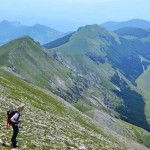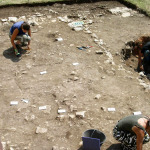The presence of human settlements in the Aterno Valley dates back to the ninth century BC. A series of discoveries made in valley, especially in the Protohistoric Necropolis of Fossa, have brought to light valuable burial evidence dating from a period about three thousand years ago, testimony that the valley was already inhabited in the so-called Iron Age. Other archaeological excavations in the valley, and in particular those of Peltuinum, give testimony of the numerous dwellings and religions of the Roman era. A visit to these excavations helps one understand the historical importance that the valley has had over the centuries.

THE NECROPOLIS OF FOSSA
The necropolis of Fossa is an archaeological site of considerable importance to Abruzzo and nationwide. Brought to light in the nineties, it is a unique testimony to Italian archaeology, especially given the fact that the tombs housed here cover a very wide time span, ranging from the tenth century BC up until the first century AD. For its exceptional value, the Necropolis has even been nicknamed “little Stonehenge.”
The 500 discovered and explored burial sites occupy a large area that covers nearly 2,000 square meters of land. Here, visitors can find different types of mounds built in very different periods. The variety of techniques used in the construction, manifests itself the temporal distance of the tombs. The oldest tombs can be traced back to the Vestini people and contain numerous objects related to everyday life. There are also circular tombs made of stones, dating back to the Iron Age (X-VII century BC) and graves of adult males, characterized by the provision of stones outside with heights (in descending order) ranging from 50 cm to 4 meters. This necropolis was later used by the Romans. During this period the graves are directed upwards and lot’s of them have facing rooms with “luxurious” funeral beds carved in bone and ivory. The Fossa archaeological site is a place with a special atmosphere, is full of mysticism and certainly warrants a visit, as it remains the most important protohistoric necropolis of Abruzzo.
Info:
www.comunedifossa.it/SANArcheologia.aspx

THE PELTUINUM ARCHAEOLOGICAL SITE
The city of Peltuinum was founded in between the first century BC and the first century AD in the territory inhabited by the people of the Vestini. It encompasses the elevated plateau of Navelli, which emerges between the Aterno Valley and the Tirino river, forming a natural route through the Abruzzo. The city had a strategic political and economic role in the control of trade related to the transhumance routes. The first excavations conducted in the city between 1983 and 1985 brought to light an impressive theater-temple complex which incorporates architectural and urban patterns typical of Augustan Rome.
The excavations that have followed have also unearthed a temple porch with three arms that surrounded the theater and a small fortified location which provides interesting testimony of Peltuinum medieval era. Between 2000 and 2002 the excavations were concentrated in the theater area, bringing to light: the part of the bleachers reserved for spectators and a system of rainwater drainage, the foundations of the lower half of the stage, the room for the maneuvering of the curtain, the porch that closed the theater complex offering viewers shelter from rain and sun during performances. Subsequent excavations have succeeded in tracing the many burial grounds of pre-Roman times in the area, and and evidence of settlements preceding the Roman period. The commitment over the years, in addition to the acquisition of important scientific data, has called attention to the joints of the architectural monument, which represents a valuable record of the history of Abruzzo from pre-Roman times to the Middle Ages.







 Italiano
Italiano  English
English